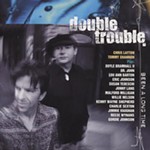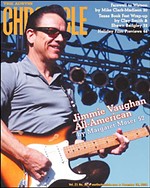And the Band Played On-Air
The Man Behind KUT's Live Set, Walter Morgan
By Andy Langer, Fri., July 19, 1996
Although Live Set has captured the energy of everybody from Stetford and the True Believers to Kirk Whalum and Butch Hancock, Morgan nonetheless admits that in the "Live Music Capital of the World," the concept of a plug-in-and-play live broadcast is a no-brainer. That's what Morgan and several other engineers and deejays told KUT General Manager Bill Giorda in 1983, when they asked for approval to begin broadcasting from the large basement storeroom in the communications building. Morgan says Giorda was quick to realize that on-air staffers like Larry Monroe, Paul Ray, and Jay Trachtenberg had long been presenting live music in the KUT control room, and that a new room and centralized day and time could alleviate KUT's concern about providing an engineer every time a station deejay got the bug for live music. Almost immediately, Giorda named the show and told Morgan to develop the concept.
"It was and still is such a basic show that there wasn't much to develop," says Morgan, who's been behind the board for each of Live Set's 517 shows. Initially, Live Set aired every two weeks, in a fixed Sunday evening slot that seemed an attractive time for both listeners and in terms of musician availability. And although Larry Monroe's "Texas Radio" presented a Jimmie Dale Gilmore show in studio 1A only a week before Live Set's February 1984 launch, Paul Ray's airing of Kazz Jazz is in the books as the first official Live Set -- unless you ask Monroe. "It's a matter of some debate," says Morgan. "Larry wants to have done the first, and Paul doesn't really care. And I did both shows, so it doesn't really matter to me."
Either way, Morgan now admits the live-on-air concept and challenge of finding a smooth sound in what was once an engineering storeroom had everyone, including Morgan, initially nervous. As such, early Live Sets featured small, semi-acoustic bands without drums. "We still weren't sure we could get a big enough sound out of the room," explains Morgan. "Now, we'll do any combination, any set-up, but it took a long time for me to believe it sounded good. People would always say it sounded good, but it probably took me five years to start believing them."
As anxious as Morgan was about the show's initial sound, he says that both he and the KUT powers that be were adamant that the show be aired in real-time, rather than tape the shows and tinker with the audio quality in post-production. "People might think that recording it could be easier, but production-wise it's infinitely harder," Morgan says. "We knew bands wouldn't be satisfied with one take and would want to do it again and again. Then someone has to decide which take is the best one. Who gets to decide? The band wants input, everybody wants input. Then, all of a sudden, you're making a record once a week, just for a one-hour radio show. That's my slogan; `We're not making a record, it's just a radio show.' I use that to try and chill guys out because sometimes they come in and think they're making a record."
But sometimes musicians are indeed coming in to make a record. Since its inception, local musicians without recorded product have used their Live Set performances as deal-shopping demos. In fact, Jimmie Dale Gilmore credits a Live Set tape as the launching pad for his first deal with HighTone. Yet in recent years, as prices for CD and cassette pressing have come down, more local acts like the Asylum Street Spankers and the Derailers have used the sets as commercially released product. Add an influx of artists with major label deals who view Live Set as an easy way to record well-produced B-sides for singles or European pressings, and the show can be seen as having taken on a whole new life beyond its original one-hour airing.
Although KUT itself has pressed three Live Set compilation CDs as pledge drive premiums, the matter of post-show commercial releases may be the program's grayest area. KUT owns the master tapes to the shows, but technically, says Morgan, nothing within the University bureaucracy stops the re-release of tapes -- mostly because the bureaucracy is too big to keep tabs on 517 Austin artists. "There has never been a prohibition against using the tapes, and there's never specific permission to use the tapes," says Morgan. And while Morgan says he supports the use of Live Set as independent cassette releases and as stage product, he's more reserved about the threat of large indies or major labels exploiting the show's catalogue.
"Sometimes great live radio doesn't make for a good recording down the line," says Morgan. "I would prefer to withhold the two-track masters unless there's a compelling reason [to release them], like Nanci Griffith or the True Believers deciding `Oh boy, I really like my old performance on Live Set.' Okay, cool. But generally, I'd like to hold the masters until we get new technology like a couple of ADATs and tell the artist if they're serious about releasing it they can buy the blank tape, and pay a nominal charge to track it. Then they would have the performance, generated by the live excitement and being on the air, that they can take to any studio in town and remix it and make a better product. We could generate a little income for the station, pass on business to local studios, and give the artists better control over the product. But you've got to buy the machines and nobody will do that for me yet, so I don't see that happening any time soon. In the meantime, I'm sure the bands will keep releasing their product." Whether or not there's a tape for sale down the line, Morgan says most musicians come in realizing straight away that Live Set's immediate value is the show's first airing -- the promotional value of reaching a dedicated KUT audience. "For the musician, it comes down to the intrinsic value of playing on a 100,000 watt radio station," Morgan says. "Any musician would be stupid to overlook that, but there's still two different types of musicians playing: the ones that do it for the enjoyment and the others who may be more career-oriented and are trying to get somewhere. Either way, they say time and time again that its a `fun' gig because playing in a controlled situation is not something you get to [do] a lot."
Morgan's reign over Studio 1A is a controlled situation as well, mostly because his game plan is so simple. KUT's deejays bring Morgan ideas for bands, firm up a date, and let the performers know when to appear for soundcheck. Then, Morgan sets up the band, gives them a dinner break, and both parties meet later for the broadcast itself. "I'm the coordinating producer in that I set up the dates, set up the bands, and record them, but the hosts are co-producers in that they find the bands and I trust them to know what will work," says Morgan. "Live Set is a reflection of the station philosophy. The station doesn't have a program director, we have 15 -- one for each show. It's an unprecedented approach and the station's real value. Live Set is where the 15 meet and contribute, so that one week it could be the Hormones and the next Willie Nelson."
And while the show's diverse roster of guests is its strength as a program, it's also what keeps Morgan on his toes as a producer. These days, Morgan says musicians of any genre or configuration are fair game, although the show has come full circle from its early days -- to the point where acoustic shows present the biggest challenges. "With just an acoustic guitar, there's no place to hide. It's all open space," Morgan says. But even with the unpredictable factors of live sound, Morgan maintains that, like any studio session, the psychology behind the session is Live Set's biggest uncertainty.
"I meet a whole group of people for the first time each week, and an hour later I have to have them all organized in a fairly small room," says Morgan, who has both a music and radio-television-film college background. "Then, I've got to sit down while they're playing, without tracks to play back, and get a sound that I'm happy with very fast. They've been together a long time, or sometimes they haven't and have their own internal conflicts going on and I've got to step into the middle of it and find a sound we can all agree on. Usually, it's not a big deal because they realize the nature of the gig and realize if it's going to work they have to trust me. All they can really do is play their best because there's no second chance."
And for all the headaches of the set-up, Morgan says the library of tapes that sits near his desk more than makes up for it. So while Larry Monroe, Dan Del Santo, and David Obberman have hosted the most Live Sets, Morgan's seen 'em all form behind the console. And as such, for a guy that rarely, if ever, goes out to the clubs to see live music, Morgan has seen 10 years of Austin music come, go, and come back again. "I've never been a nightclub kind of person," says the engineer. "My joke is that I don't have to go out to the clubs, because the bands come to me. And this way, it's all discovery for me.
"It's kind of hard to relate it to a broader thing -- Austin music as a whole -- because they come in, do the show, and leave. Nine times out of 10, I never see them again. I'm like a doctor in that way. And of course, there are some people over the years that you develop a relationship with and know, mostly the guys that play in a lot of different bands."
But isn't Live Set's ultimate legacy that it's captured hundreds of those musicians Morgan's met over and over, in hundreds of now-defunct bands? "That's for an archivist to answer in the future," answers Morgan, adding that one day he hopes to make the Live Set collection available as part of UT's library system. "I'll tell you, if someone wanted to do a book, they could probably listen to all these tapes and get a great one just from the information of who's playing, what clubs were open, and who was at what point in their career. There's a huge amount of historical information on these tapes in the interview and plugs alone. And then there's the music...." Andy Langer does Sunday overnights on KUT and has hosted two Live Sets: The Billy White Trio and Fastball.







